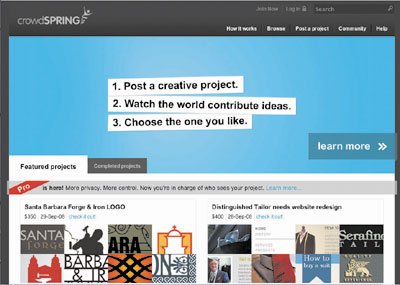Trying to begin a career as a graphic designer and build a
portfolio, Evan Stremke joined CrowdSpring, a Chicago-based online
marketplace for creative services.
Eric Benderoff – Chicago Tribune
ed****@****ic.com
CHICAGO
Trying to begin a career as a graphic designer and build a portfolio, Evan Stremke joined CrowdSpring, a Chicago-based online marketplace for creative services.
No conventional help-wanted Web site, CrowdSpring is part of a trend sweeping the Web, sometimes called crowd sourcing. The idea is to set up an open, online competition among talent who bid for jobs doing everything from creating a corporate logo to writing blog entries.
The 20-year-old student from Minnesota vies for work against stay-at-home moms, professional designers and others who want to hone their skills. Only the winner gets paid, and some jobs generate hundreds of entries.
It sounds like a nightmare – going up against scores of other designers and showing off your work in public, effectively giving up your ideas for free.
But in the age of the Internet, where people are willing to share intimate details on MySpace or Facebook, the concept of crowd sourcing fits the zeitgeist. It’s also catching on because it is efficient, with talent and clients exchanging ideas until they home in on winners.
Competing for work against so many peers is “not for everybody,” said Mike Samson, CrowdSpring’s co-founder. “But it is for many.”
On the Web, employers can tap into this global network of contractors willing to work on “spec.” But for people like Stremke, it also provides an environment where he can learn from others in the same profession. The work is put on a Web page for everyone to see and critique. The client eventually picks a winner and pays.
“It would make me nervous if it were my only source of income,” said Chrissy Richards, a stay-at-home mom who uses CrowdSpring to supplement earnings from her home-based graphic design firm in Eugene, Ore.
“I’ve won 12 jobs in about two months. I’ve submitted designs for about 76,” she said. “That’s not bad, probably a pretty good ratio compared to some other designers, but I wish it were more.”
The jobs have paid between $170 and $350. She’s made $2,895 in three months and her clientele stretches from Australia to the United Kingdom.
Other Web sites taking a similar approach include Guru, Kluster and Minted, a site for paper enthusiasts. Threadless, a Chicago T-shirt retailer specializing in user-submitted designs, sells only shirts that have been approved by a public vote.
Typically, such sites generate revenue by charging clients a fee for hiring talent. At CrowdSpring, it’s 15 percent on top of the bid.
David Freibrun, a software engineer and father, is launching a baby photo blog in September to share advice on how to capture cute pictures of kids.
He plans to build and promote MyBabyPhotos.net, so he put out a bid on Guru.com, a marketplace for freelancers, to hire writers. He got more than 100 responses.
Freibrun will pay only for the posts he uses. He’d like to pay all the writers who submitted an entry but his site is self-funded.
“I’m starting out at $40 per post,” he said. He hopes to find 20 writers willing to contribute regularly.
Ben Kaufman started Kluster.com after he witnessed the power of collaboration. His first firm, Mophie, made iPod accessories.
“We were just another company making condoms for the iPod,” he said, noting that so many firms were making cases for Apple Inc.’s music players that his product had become a commodity. “There was nothing exciting about what we were doing.”
At the 2007 Macworld convention, Kaufman’s booth offered no products. Instead, he asked attendees to sketch a design for an iPod case. He received 30,000 submissions. “We had a winner by the end of the show.”
Six weeks later, the $15 Bevy was on store shelves at Apple stores and other retailers across 28 countries. It’s an iPod Shuffle case that doubles as a bottle opener, designed by a high-school student.
“If I designed it in my office, no one would be excited about it,” he said. “But since it had a great back story, people were excited about the Bevy.”
The Bevy’s success helped Kaufman sell Mophie for an undisclosed sum. In March, he launched Kluster, a business that sells the collaborative culture.
The “Kluster-powered” Web site NameThis.com, lets an aspiring entrepreneur, for $99, ask the community to help name a new company, product or service. The group brainstorm lasts 48 hours.
If your suggestion wins, you earn $40. Second- and third-place winners receive small awards.
One recently completed naming contest was for a “Web 2.0 green portal,” meaning it will be a Web site for environmental topics and products. The winning name: GreenKeeper.
“We’re still finding our groove,” Kaufman said. “I strongly believe that if we continue to prove the viability of group decision-making, this will be fairly lucrative. The more minds the better.”
CrowdSpring’s Samson and co-founder Ross Kimbarovsky believe they are tapping into a huge market for creative talent.
“We’ve had buyers from India and creatives from the U.S. doing the work for them,” Samson said. “Talk about a turnaround.”
Still, if you’re a designer, it can be tough to make a buck. About 90 percent of CrowdSpring’s registrants have yet to win an award.
If you’re a firm looking for a new logo, CrowdSpring guarantees at least 25 entries. “Some projects have gotten more than 400,” Kimbarovsky said.
Roughly 5,000 designers from about 125 countries have joined CrowdSpring to bid for work since the Web site launched in May.
Designers can bid on work for print or Web design, icons, illustrations, photography and PowerPoint presentations. The biggest category is for logo work.
That’s what Richards, the Oregon mom, prefers.
“When I see a project that gives me an immediate idea I can knock off in a few hours, I’ll do it,” she said.
Also, she’s learning.
“My logo design work has improved about 200 percent,” she said. “I like the competitive nature because it makes my work better.”
Stremke has a similar opinion: “If I don’t give the clients what they want, I won’t get paid.”
Stremke has earned $1,400 on CrowdSpring, winning five of the 81 projects he has bid on. But even on the jobs he hasn’t won, he is developing his skills. The college junior also is rethinking his options as he works toward graduation.
“This has given me a lot of perspective, helped to put things in order on how I want to schedule the rest of my classes,” he said.
One lesson: Being a successful designer is not just about good logo work.
“I’m looking at more business classes.”














